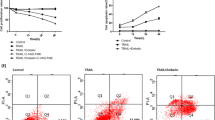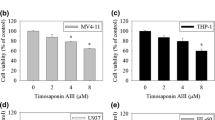Abstract
The inhibitor of apoptosis proteins (IAPs) is closely related to leukemia apoptosis. The present study was undertaken to determine the molecular mechanisms by which GDC-0152, an IAP inhibitor, induces apoptosis in human leukemia cells (K562 and HL60 cells). GDC-0152 inhibited the proliferation of K562 and HL60 cells in a dose- and time-dependent manner, which was largely attributed to intrinsic apoptosis. GDC-0152 down-regulated the IAPs including X-linked inhibitor of apoptosis protein (XIAP), cellular inhibitor of apoptosis protein-1 (cIAP1), and cellular inhibitor of apoptosis protein-2 (cIAP2) expression and induced the activation of caspase-9 and caspase-3. GDC-0152-induced cell proliferation inhibition in K562 cells was prevented by pan-caspase inhibitor. GDC-0152 also inhibited PI3K and Akt expression in K562 and HL60 cells. Taken together, these findings suggest that GDC-0152 results in human leukemia apoptosis through caspase-dependent mechanisms involving down-regulation of IAPs and inhibition of PI3K/Akt signaling.







Similar content being viewed by others
References
Lengfelder E, Hofmann WK, Nowak D. Treatment of acute promyelocytic leukemia with arsenic trioxide: clinical results and open questions. Expert Rev Anticancer Ther. 2013;13(9):1035–43.
Grzybowska-Izydorczyk O, Cebula B, Robak T. Expression and prognostic significance of the inhibitor of apoptosis protein (IAP) family and its antagonists in chronic lymphocytic leukaemia. Eur J Cancer. 2010;46(4):800–10.
Sung KW, Choi J, Hwang YK. Overexpression of X-linked inhibitor of apoptosis protein (XIAP) is an independent unfavorable prognostic factor in childhood de novo acute myeloid leukemia. J Korean Med Sci. 2009;24(4):605–13.
Ibrahim AM, Mansour IM, Wilson MM. Study of survivin and X-linked inhibitor of apoptosis protein (XIAP) genes in acute myeloid leukemia (AML). Lab Hematol. 2012;18(1):1–10.
Flygare JA, Fairbrother WJ. Small-molecule pan-IAP antagonists: a patent review. Expert Opin Ther Pat. 2010;20(2):251–67.
Varfolomeev E, Vucic D. Inhibitor of apoptosis proteins: fascinating biology leads to attractive tumor therapeutic targets. Future Oncol. 2011;7(5):633–48.
Kashkar H. X-linked inhibitor of apoptosis: a chemoresistance factor or a hollow promise. Clin Cancer Res. 2010;16(18):4496–502.
Hu R, Zhu K, Li Y. Embelin induces apoptosis through down-regulation of XIAP in human leukemia cells. Med Oncol. 2011;28(4):1584–8.
Lanuti P, Bertagnolo V, Pierdomenico L. Enhancement of TRAIL cytotoxicity by AG-490 in human ALL cells is characterized by downregulation of cIAP-1 and cIAP-2 through inhibition of Jak2/Stat3. Cell Res. 2009;19(9):1079–89.
Flygare JA, Beresini M, Budha N. Discovery of a potent small-molecule antagonist of inhibitor of apoptosis (IAP) proteins and clinical candidate for the treatment of cancer (GDC-0152). J Med Chem. 2012;55(9):4101–13.
Yue Q, Mulder T, Rudewicz PJ. Evaluation of metabolism and disposition of GDC-0152 in rats using 14C labeling strategy at two different positions: a novel formation of hippuric acid from 4-phenyl-5-amino-1,2,3-thiadiazole. Drug Metab Dispos. 2013;41(2):508–17.
Liao A, Hu R, Zhao Q. Autophagy induced by FTY720 promotes apoptosis in U266 cells. Eur J Pharm Sci. 2012;45(5):600–5.
Wu CC, Bratton SB. Regulation of the intrinsic apoptosis pathway by reactive oxygen species. Antioxid Redox Signal. 2012;19(6):546–58.
Rahmani M, Aust MM, Attkisson E. Dual inhibition of Bcl-2 and Bcl-xL strikingly enhances PI3K inhibition-induced apoptosis in human myeloid leukemia cells through a GSK3- and Bim-dependent mechanism. Cancer Res. 2013;73(4):1340–51.
Czabotar PE, Lessene G, Strasser A. Control of apoptosis by the BCL-2 protein family: implications for physiology and therapy. Nat Rev Mol Cell Biol. 2013;15(1):49–63.
Pathania AS, Guru SK, Verma MK. Disruption of the PI3K/AKT/mTOR signaling cascade and induction of apoptosis in HL-60 cells by an essential oil from Monarda citriodora. Food Chem Toxicol. 2013;62:246–54.
Wang R, Cong WH, Guo G. Synergism between carnosic acid and arsenic trioxide on induction of acute myeloid leukemia cell apoptosis is associated with modulation of PTEN/Akt signaling pathway. Chin J Integr Med. 2012;18(12):934–41.
Hales EC, Orr SM, Larson Gedman A. Notch1 receptor regulates AKT protein activation loop (Thr308) dephosphorylation through modulation of the PP2A phosphatase in phosphatase and tensin homolog (PTEN)-null T-cell acute lymphoblastic leukemia cells. J Biol Chem. 2013;288(31):22836–48.
Ni T. The ubiquitin ligase ability of IAPs regulates apoptosis. IUBMB Life. 2005;57(12):779–85.
Danquah M, Duke 3rd CB, Patil R. Combination therapy of antiandrogen and XIAP inhibitor for treating advanced prostate cancer. Pharm Res. 2012;29(8):2079–91.
Nestal de Moraes G, Vasconcelos FC. Doxorubicin induces cell death in breast cancer cells regardless of survivin and XIAP expression levels. Eur J Cell Biol. 2013;92(8–9):247–56.
Baykara M, Yaman M, Buyukberber S. Clinical and prognostic importance of XIAP and USP8 in advanced stages of non-small cell lung cancer. J BUON. 2013;18(4):921–7.
Schimmer AD, Herr W, Hänel M. Addition of AEG35156 XIAP antisense oligonucleotide in reinduction chemotherapy does not improve remission rates in patients with primary refractory acute myeloid leukemia in a randomized phase II study. Clin Lymphoma Myeloma Leuk. 2011;11(5):433–8.
Gagnon V, Van Themsche C, Turner S. Akt and XIAP regulate the sensitivity of human uterine cancer cells to cisplatin, doxorubicin and taxol. Apoptosis. 2008;13(2):259–71.
Cully M, You H, Levine AJ. Beyond PTEN mutations: the PI3K pathway as an integrator of multiple inputs during tumorigenesis. Nat Rev Cancer. 2006;6(3):184–92.
Conflicts of interest
None
Author information
Authors and Affiliations
Corresponding author
Rights and permissions
About this article
Cite this article
Hu, R., Li, J., Liu, Z. et al. GDC-0152 induces apoptosis through down-regulation of IAPs in human leukemia cells and inhibition of PI3K/Akt signaling pathway. Tumor Biol. 36, 577–584 (2015). https://doi.org/10.1007/s13277-014-2648-8
Received:
Accepted:
Published:
Issue Date:
DOI: https://doi.org/10.1007/s13277-014-2648-8




